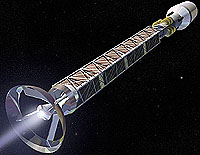|
||||||||
|
by Ron Koczor
Well, to a few scientists and university
researchers, antimatter may just be the future of human space travel.
When it comes to packing a punch, antimatter/matter reactions can't
be beat. When a particle and its antiparticle meet, they annihilate
each other and their entire mass is converted into pure energy.
Many physics textbooks describe matter as something "that takes up space and has mass." Every physical object that you've ever seen consists of matter. So if everything you know is made of matter, then what's antimatter? Let's go back to the 1930s to find an answer. In 1928, the British physicist Paul
A.M. Dirac (1902-1984) formulated a theory for the motion of electrons
in electric and magnetic fields. Such theories had been formulated
before, but what was unique about Dirac's was that his included
the effects of Einstein's Special Theory of Relativity. Dirac's
equations worked exceptionally well, describing many attributes
of electron motion that previous equations could not. But his theory also led to a surprising prediction that the electron must have an "antiparticle," having the same mass but a positive electrical charge (the opposite of a normal electron's negative charge). In 1932 Carl Anderson observed this new particle experimentally and it was named the "positron." This was the first known example of antimatter. In 1955 the antiproton was produced at the Berkeley Bevatron, and in 1995 scientists created the first anti-hydrogen atom at the CERN research facility in Europe by combining the anti-proton with a positron (the normal hydrogen atom consists of one proton and one electron). But when these antihydrogen atoms are produced, they are travelling at nearly the speed of light and don't last too long (40 nanoseconds is typical). Dirac's equations predicted
that all of the fundamental particles in nature must have a corresponding
"antiparticle." In each case, the masses of the particle and antiparticle
are identical, and other properties are nearly identical. But in
all cases, the mathematical signs of some property are reversed.
Antiprotons, for example, have the same mass as a proton but the
opposite electric charge. Since Dirac's time, scores of these particle-antiparticle
pairings have been observed. Even particles that have no electrical
charge, such as the neutron, have antiparticles. These have other
properties with a sign (such as magnetic moment) that can be reversed.
The tentative answer (and it is tentative, since this question is a topic of on-going research) is in the word almost. Present theory suggests that if particles outnumbered antiparticles in the Big Bang by as little as one part in 100 million, then the present universe could be explained by those extra particles that were not annihilated by an antiparticle counterpart. Other theories suggest that even if identical amounts of antimatter and matter were created in the Big Bang, the physics of antimatter and matter are slightly different. This hypothesized difference would favour residual matter after all original antimatter had been annihilated. So that's what antimatter is. Are we sure that there is no antimatter left in the universe? Dr. Charles Meegan, an astrophysicist
at the Marshall Space Flight Centre, noted that orbiting gamma-ray
observatories have measured the sky in the range of energies that
would have detected the telltale signature of antimatter annihilation.
On Earth all antimatter that exists is counted in individual atoms. Low energy positrons are routinely used in a medical imaging technique called Positron Emission Tomography as well as studies of important materials used in electronics circuits. These positrons are the result of the natural decay of radioactive isotopes. While useful in medical and materials research applications, there are not enough of these anti-electrons to provide a useful form of rocket fuel. High-energy antimatter particles are only produced in relatively large numbers at a few of the world's largest particle accelerators. The current worldwide production rate of antimatter is on the order of 1 to 10 nanograms (billionths of a gram!) per year. How can antimatter help human exploration
of space? The answer lies in Einstein's famous equation E=mc2.
When antimatter annihilates normal matter, all the mass is converted
to energy. The energy output per unit particle vastly exceeds the
efficiency of chemical reactions such as burning hydrogen and oxygen
in the Space Shuttle main engines. So, could an antimatter future
lie ahead for space travel?... Now read our follow up Article to this Reaching for the Stars |
||||||||

